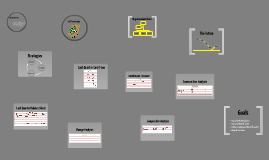annual report
Transcript: Peritoneal Dialysis Unit KKUH 2012 the degree to which health services for individuals and populations increase the likelihood of desired health outcomes and are consistent with current professional knowledge” (Lohr, 1990). As hyperkalemia and hypokalemia, both are associated with significant risk of arrhythmias, it is recommended to maintain serum potassium levels within the recommended Range of 3.5 – 5.1 mmol/L Serum K Target Range (3.5 – 5.1 mmol/L) Below Target Range 8 patients ( 14.28 %) Within Target Range 44 patients ( 78.57 %) Above Target Range 4 patients ( 6.66 %) Cause Commonly due to non compliance with dietary restrictions Managed by oral Calcium resonium Re education about diet by PD staff and clinical nutritionist. Bone mineral metabolism: KDIGO Guidelines for Bone mineral metabolism 2007 In patients with CKD stage 3-5D, we suggest lowering elevated phosphorus levels toward the normal range (1.13-1.78 mmol/L) We suggest maintaining serum corrected calcium in the normal range (2.20-2.37 mmol/L) The serum calcium-phosphorus product (Ca X Ph Product) should be maintained at (< 4 mmol/L or <55 mg2/dL2 ) We suggest using a dialysate calcium concentration between 1.25 and 1.50 mmol/l (2.5 and 3.0 mEq/l) Serum corrected Ca Target Range Below Target Range 7 patients (12.5 %) Within Target Range 46 patients ( 82.1%) Above Target Range 3 patients (5.35 %) Inorganic Ph Target Range Below Target Range 1 patients ( 1.78 %) Within Target Range 35 patients ( 62.5 %) Above Target Range - 20 patients ( 35.7 %) Ca X Ph Product (Target < 4 mmol/L) Within Target Range 37 patients ( 66.1 %) Above Target Range - 19 patients ( 33.9 %) All patients were using low calcium peritoneal dialysis fluid with 1.25 mmol/L of calcium. Most cases of patients presenting with lower than target calcium levels, the cause was found to be inadequate oral replacement (low dose or non compliance). All patients were given advice regarding correct dosage, interactions and timing of calcium supplements. Guidelines for PTH, as per KDIGO Recommendations In patients with CKD stage 5 D, we suggest maintaining iPTH levels in the range of approximately two to nine times the upper normal limit for the assay (14- 62 pmol/L) Used as an indicator of nutritional status in dialysis patients Significantly greater prevalence of cardiovascular complications and higher mortality Patients using PD are at a greater risk of hypo-albuminemia, as albumin is lost in the dialysis fluid. Serum Albumin Target Range (> 30 gm/L) Within Target Range 33 patients ( 58.93 %) Below Target Range 23 patients ( 41.07 %) Patients with hypoalbuminemia were counseled about improving protein intake by the clinical nutritionist as well as peritoneal dialysis staff. In some cases the patients needed nutritional supplements. ANEMIA KDOQI Clinical Practice Guideline Target hemoglobin (Hb) levels In the opinion of the Work Group, in dialysis and nondialysis patients with CKD receiving ESA therapy, the selected Hb target should generally be in the range of 11.0 to 12.0 g/dL. Hypo response to ESA and iron therapy: the patient with anemia and CKD should undergo evaluation for specific causes of hypo response whenever the Hb level is inappropriately low for the ESA dose administered. 22 (39.28 %) - hemoglobin levels within the target range, 22 (39.28 %)- levels below the target range, 12 (21.43 %) - levels above the upper limit of 12 g/dL. the cause dietary iron deficiency or problems with administration of erythropoietin injections incorrect dosage storage and administration technique non compliance to treatment). In many cases, the levels of hemoglobin improved with iron supplements (oral and IV) and continuous patient education. All patients with persistent low hemoglobin levels despite adequate iron stores (manifest by serum iron levels and transferrin saturation TSAT) and optimal erythropoietin replacement were evaluated for specific causes of hypo-responsesiveness. Evaluation included screening for gastro intestinal bleeding, hemoglobinopathies, malignancy, other inflammatory conditions and resistance to erythropoietin. For patients with higher than recommended Hb levels, the dose of ESA was reduced or discontinued for a few weeks, to bring Hb levels within target range. Adequacy guidelines Both the KDOQI 2006 and Canadian 2011 guidelines, suggest a minimum clearance target of 1.7, for Kt/V, no fixed value for total creatinine clearance. However, previous guidelines recommended achieving a minimum CCr of 45 L/wk/1.73 m2 conclusion A considerable percentage of our patients had elevated PTH levels, can be attributed to Chronic Kidney Disease Bone Mineral Disorders (CKD-BMD), encompasses clinical biochemical and bone alterations including secondary hyperparathyroidism, Patients with significantly elevated PTH levels were treated with oral Vitamin D (1alpha-hydroxyvitamin D3) and calcimimetic (cinacalcet), with close follow up. Peter G. Blake, Joanne M. Bargman, K. Scott Brimble,

















